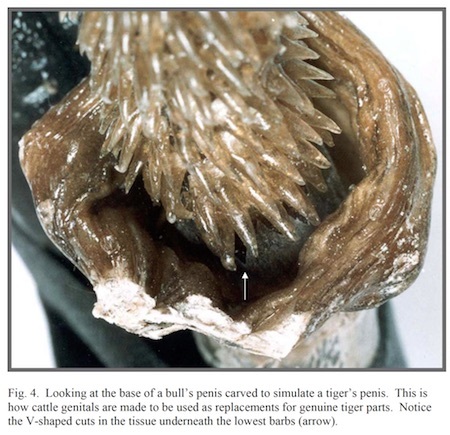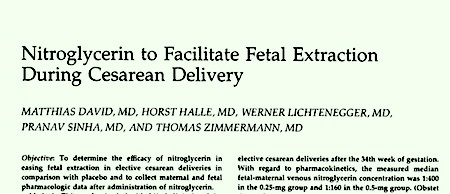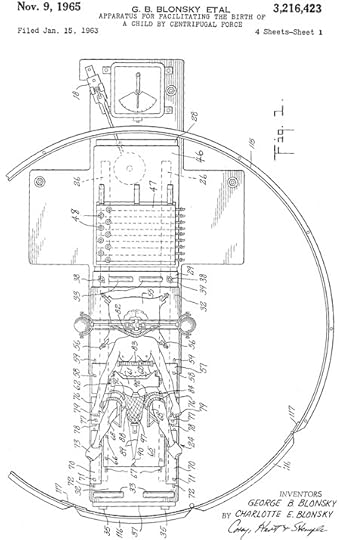Marc Abrahams's Blog, page 209
October 2, 2017
Distinguishing Real vs Fake Tiger Penises [law enforcement guide]
This eight-page report is a practical guide for law enforcement officials:
“Distinguishing Real vs Fake Tiger Penises,” Bonnie C. Yates, Identification Guides for Wildlife Law Enforcement No. 6., 2005, U.S. Fish and Wildlife Service, National Fish and Wildlife Forensics Laboratory, Ashland, Oregon. (Thanks to Silvan Urfer for bringing this to our attention.) The author reports:
“Dried genitalia are an important element of traditional medicine in many cultures around the world…. Wildlife law enforcement officers can learn to differentiate the various species sources of these products and detect genuine tiger penises from the abundant fakes currently being sold to unsuspecting tourists and consumers.
“In animal markets, some parts and products are not what they are labeled. One of the most difficult products to identify has been genuine dried tiger penises. The reason for this is the rarity of the real thing and a long tradition of the production of ‘lesser tiger’ or tiger substitute, that is, any other large mammal that can be promoted as a replacement for tiger. When rehydrated and consumed in a soup or tea, this product is believed to serve as an aphrodisiac or restorative tisane. To date, no dried penis from an actual tiger has been seen in the Lab as evidence in a wildlife case.”
The photo above, from the report, comes with this caption: “Fig. 4. Looking at the base of a bull’s penis carved to simulate a tiger’s penis. This is how cattle genitals are made to be used as replacements for genuine tiger parts. Notice the V-shaped cuts in the tissue underneath the lowest barbs (arrow).”
BONUS FACT: The 1992 Ig Nobel Prize for Art was awarded to to Jim Knowlton, for his classic anatomy poster “Penises of the Animal Kingdom,” and to the U.S. National Endowment for the Arts for encouraging Mr. Knowlton to extend his work in the form of a pop-up book.

Frost on Ice
 Another case of nominative determinism:
Another case of nominative determinism:
If you want to make steps towards understanding the highly complex issues regarding how when and why ice cracks, you’ll probably need the help of an expert on the subject. Who better to turn to than Professor Frost of the Thayer School of Engineering at Dartmouth, Hanover, New Hampshire, US, who has extensively studied such things.
See: ‘Mechanisms of crack nucleation in ice’ published in the journal Engineering Fracture Mechanics, Volume 68, Issues 17–18.

September 28, 2017
“Dead Cat Bounce” (an elucidation)
If you’re not sure what the phrase “Dead Cat Bounce” might mean, then the online pages of the journal Medical Economics are at hand for assistance. The publication informs, with regard to Dead Cat Bounce :
“
That term refers to a stock that’s had a rapid, steep decline, followed by a brief rally. Like a dead cat dropped from the roof of a building, it may bounce up a little, but that doesn’t mean it has another life left.”
Also noted are : “Bottom fisher.” “Pump and dump” and “Cats and dogs”
See: The “dead cat bounce” and other financial jargon

September 27, 2017
The birth of the Big Bang Theory
This study is, quite plainly, the birth of the Big Bang Theory:
“Nitroglycerin to Facilitate Fetal Extraction During Cesearean Delivery,” M. David, H. Halle, W. Lichtenegger, P. Sinha, and T. Zimmerman, Obstetrics and Gynecology, vol. 91, no. 1, January 1998, pp. 119-24. (Thanks to Richard Leavitt for bringing this to our attention.) The authors are, or were, at Humboldt University in Berlin.
The study includes a most curious Table 2, which is labeled “Number of Surgeons Involved and Duration of Their Careers”:
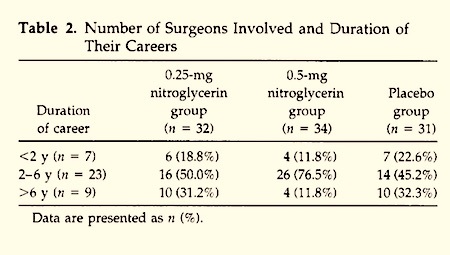
BONUS (unrelated): By some reckoning, this follows in the footsteps or flight path of the Blonsky Device:

September 26, 2017
What is this Ig Nobel thing?
Feeling uncertain about the Ig Nobel Prizes? Here are some recent reports that might clarify things — might make you LAUGH, then THINK:
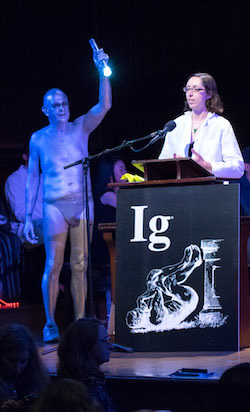 “Weird Science: Liquid-and Cats and Other Research from 2017’s Ig Nobel Awards,” The New Stack
“Weird Science: Liquid-and Cats and Other Research from 2017’s Ig Nobel Awards,” The New Stack
“Flamethrower against car lovers and gadget from long conversations: the top inventions of the winners of the Ig Nobel Prize“, Onliner [Russia]
“IG Nobel: of science and of humor” [ VIDEO ], Le 1945 [France]
“The Ig Nobel Awards 2017“, Naukas [Spain]
“Is the cat a liquid or solid? Hold crocodile gambling bigger? 2017 funny Nobel Prize winners ” part 1and part 2 [ VIDEO ], Mirror Weekly [Taiwan]
“IgNobel, ecco la pazza scienza dei vincitori del 2017“, Wired [Italy]
“Expect the Unexpected at the 2017 Ig Nobel Prize Ceremony” and ” The 2017 Ig Nobel Awards: Cats Flow Like Liquids and Didgeridoos Stop Snoring ” and “Liquid ‘Cats and Old Men’s Big Ears: Humorous Research Abounds at the Ig Nobels” and “In Photos: The Science and Silliness of the 2017 Ig Nobels” and [VIDEO], Livescience
And a fun, half-hour-long radio musing/analysis on BFM-89.9’s Health News Digest radio program [AUDIO] [Malaysia]

BONUS: Some fun video news reports about the 2017 ceremony.

September 25, 2017
The Ziptune® musical zipper (new patent)
Inventor Stan Divranos, of Chino, California, has just been granted a US patent (Aug 29th 2017) for his Ziptune® musical zipper.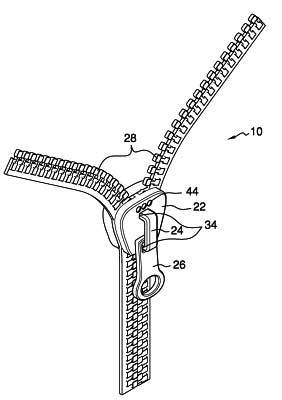
“Various types of zippers are known in the prior art. However, what has been needed is a musical zipper including a zipper having a slider, a continuous C-shaped flap having a pair of outer ends attached to a front surface of the slider, a pull tab engaging the flap, a pair of interlocking teeth having a first interlocking member and a second interlocking member, a speaker disposed on the front surface of the slider, and a sound chip disposed within the slider. What has been further needed is for the slider to be configured to travel from a first end of the zipper to a second end of the zipper to connect the first interlocking member with the second interlocking member and for the slider to be configured to travel from the second end of the zipper to the first end of the zipper to disconnect the first interlocking member from the second interlocking member. Lastly, what has been needed is for the sound chip to be configured to play a musical tune when the sound chip is activated.“
Bonus Assignment [optional] What tune (or tunes) would be most suitable for the Ziptune® to play? [ please comment with your suggestions below ]
BONUS [One answer to that question is the song “Zip-a-dee-doo-dah”:

September 23, 2017
Highly Technical Explication of a Simple Surprise About Surprise
Three researchers put into words their simple surprise about surprise. They published a study that goes into considerable detail. It has to do with the facial appearance of people who are surprised by something.
Here, for context, is a random selection of photos turned up by a google search for the phrase “surprised faces”:
 The study is: “The Cognitive-Evolutionary Model of Surprise: A Review of the Evidence,” Rainer Reisenzein [pictured here], Gernot Horstmann, and Achim Schützwohl, Topics in Cognitive Science, epub 2017.
The study is: “The Cognitive-Evolutionary Model of Surprise: A Review of the Evidence,” Rainer Reisenzein [pictured here], Gernot Horstmann, and Achim Schützwohl, Topics in Cognitive Science, epub 2017.
The authors, at the University of Greifswald, the University of Bielefeld, and Brunel University London, explicate their finding.
If you want to consider some of the detail that they (the researchers) consider you (the reader) should consider, here is the researchers’ 140-word partial summary of what they found surprising. You might enjoy reading it aloud to a friend:
“The facial expression of surprise postulated by evolutionary emotion psychologists has been found to occur rarely in surprise, for as yet unknown reasons. A physiological orienting response marked by skin conductance increase, heart rate deceleration, and pupil dilation has been observed to occur regularly in the standard version of the repetition-change paradigm of surprise induction, but the specificity of these reactions as indicators of surprise is controversial. There is indirect evidence for the assumption that the feeling of surprise consists of the direct awareness of the schema-discrepancy signal, but this feeling, or at least the self-report of surprise, is also influenced by experienced interference. In contrast, facial feedback probably does contribute substantially to the feeling of surprise and the evidence for the hypothesis that surprise is affected by the difficulty of explaining an unexpected event is, in our view, inconclusive.”
BONUS (unrelated): The city of Surprise, Arizona.
BONUS (related to that unrelated bonus): Trash and recycling in the city of Surprise

September 22, 2017
Some news video looks at the 2017 Ig Nobel Prize ceremony
Here are some video news reports about the 27th First Annual Ig Nobel Prize ceremony. (For lots more press accounts, dip into our Press Clips page.)
El Pais [Spain]
Mirror Weekly [Taiwan]:
Euronews:
NHK [Japan]:
Livescience:
VTC14 [Vietnam]:
RTO [The Netherlands]:
France Inter:
Canal+ [France]
Les IG Nobel, les prix Nobel des découvertes décalées (mais sérieuses) – 16/09/2017
Stiripesurse [Romania]:
United News International:
CNews [France]:
Le1945 [France]:

September 21, 2017
Attracting birds – with a ‘Songbird Magnet’
Want to attract birds? Specifically, Purple Martins or Eastern Bluebirds, Baltimore Orioles, House Wrens, House Finches, American Goldfinches, & Indigo Buntings etc etc. Then you could try the Bird-X Songbird Magnet.
“As bird lovers, it only makes sense with the science & resources we have available, to offer an electronic songbird attractant.”
– say the manufacturers. As a further refinement, if you’re keen on all the birds listed above, but just can’t abide woodpeckers, you could also invest in the Bird-X Woodpecker PRO
“Naturally recorded woodpecker distress calls & predator cries confuse, frighten, & disorient woodpeckers, forcing them to seek calmer space. “
BONUS: A streaming radio service of birdsong (Note: may include woodpeckers)

September 19, 2017
Head-Shaking Research — Ejecting Water From the Ear Canals
Ejecting water from a person’s ear canals is potentially thrilling, for fluid dynamicists and perhaps for the person. New research on the how and why will be presented at a meeting in November:
“Acceleration induced water removal from ear canals,” Hosung Kang, Katelee Averett, and Sunghwan Jung, paper (Abstract D5.00007) to be presented at the 70th Annual Meeting of the APS Division of Fluid Dynamics, November 19–21, 2017; Denver, Colorado. The researchers, at Virginia Tech, report:
 “Children and adults commonly experience having water trapped in the ear canals after swimming. To remove the water, individuals will shake their head sideways. Since a child’s ear canal has a smaller diameter, it requires more acceleration of the head to remove the trapped water.
“Children and adults commonly experience having water trapped in the ear canals after swimming. To remove the water, individuals will shake their head sideways. Since a child’s ear canal has a smaller diameter, it requires more acceleration of the head to remove the trapped water.
In this study, we theoretically and experimentally investigated the acceleration required to break the surface meniscus of the water in artificial ear canals and hydrophobic-coated glass tubes. In experiments, ear canal models were 3D-printed from a CT-scanned human head. Also, glass tubes were coated with silane to match the hydrophobicity in ear canals. Then, using a linear stage, we measured the acceleration values required to forcefully eject the water from the artificial ear canals and glass tubes.”
The lab has also done research on how dogs drink, how cats drink, how diving birds enter the water, how raindrops hit tree leaves, what happens when wet hands clap, and other not-at-all-simple simple-seeming questions.
(Thanks to Nicole Sharp for bringing this to our attention.)

Marc Abrahams's Blog
- Marc Abrahams's profile
- 14 followers


